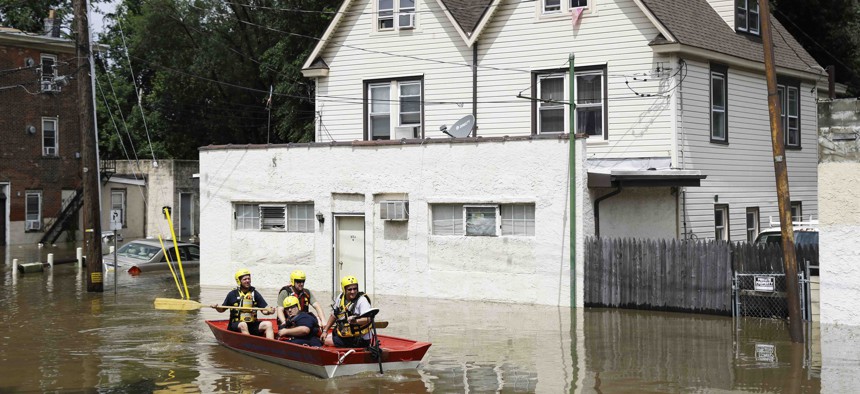With New Funding Elusive, a Governor Turns to Planning to Address Flood Hazards

First responders make their way through floodwaters in Darby, Pa., Monday, Aug. 13, 2018. AP Photo/Matt Rourke
Pennsylvania Gov. Tom Wolf outlined a three-pronged initiative this week. “It’s the best we can do right now,” he said.
Pennsylvania residents in recent years have dealt with repeated flooding that caused millions of dollars in damage to homes, businesses and infrastructure. But the destruction from many of these floods, while bad, wasn’t severe enough to qualify the state for federal disaster aid that could help pay for recovery costs.
Gov. Tom Wolf, meanwhile, has unsuccessfully pushed during the past couple of years for a $4.5 billion infrastructure plan that would in part improve flood protection, while also directly helping people whose property has been damaged by disasters like flooding.
Republicans, who control the state legislature, so far haven’t gotten onboard with the proposal, which would include a tax on gas drillers.
It’s against this backdrop that Wolf this week outlined a set of three planning measures meant to help better position the state to handle flooding and other climate threats. However, the initiatives will not provide any money for upgrading public works or mitigation efforts.
“It’s the best we can do right now,” he said.
Wolf said he would direct the state’s planning board to develop a series of recommendations and best practices about land use, planning, zoning and stormwater management, with an emphasis on reducing the risks and damage from flash flooding.
He also said he would ask the board to establish state goals and strategic investment principles for infrastructure and hazard mitigation planning. And he said his administration would seek to institutionalize these sorts of goals and principles across all state agency spending programs, so that they help to guide future decisions in areas like building roads and waterworks.
“It's only a first step,” Wolf said. “Let's start this process by developing the plan. This is what we can do now without the funding.”
President-elect Joe Biden has indicated that one of his top priorities will be addressing climate change, including by building out infrastructure that is more resilient to extreme weather events.
If Republicans keep control of the U.S. Senate by winning one of two runoff elections in Georgia next month, getting consensus in Congress on a major climate bill is likely to be difficult. But there could be better odds for bipartisan cooperation on infrastructure legislation and, with it, programs to upgrade public works in ways that might help improve the nation's resiliency to natural disasters.
Wolf wasn’t the only Democratic state and local leader to unveil a climate-related measure this week, perhaps signaling an increased focus on the issue as Biden’s tenure approaches.
In Nevada, Gov. Steve Sisolak touted the release of a new state climate strategy. And, in Seattle, Mayor Jenny Durkan said the city would tightly restrict the use of fossil fuels in the heating of new commercial and large multi-family construction to help curb emissions.
Wolf said communities in Pennsylvania have struggled with climate-related hazards that were once rare, including short but intense rains in places that were not historically flood prone.
Because these storms come and go quickly, and are in relatively small geographic areas, he said they often fail to meet the thresholds required to trigger federal disaster aid, but can still have devastating effects on the communities they strike.
“This can leave municipalities, it can leave the state, struggling to cover millions of dollars of recovery costs,” Wolf said.
In 2018, Wolf said a series of severe weather events damaged more than 5,000 Pennsylvania homes. But no single event qualified for federal aid. In that year, he said, the state faced about $63 million in public infrastructure damage that wasn’t federally reimbursable.
"We've seen more flash flooding recently than we've ever seen,” said Pennsylvania Emergency Management Agency director Randy Padfield. “The statistics show that it is increasing yearly.”
Padfield explained that flooding, both flash floods and from overflowing rivers, is the most significant natural disaster that affects Pennsylvania on a repeated basis. He said changing weather, patterns with construction and development and outdated infrastructure are all factors with repeated flood situations the state is seeing in some areas.
“Unfortunately we have ailing infrastructure across the state and the amount of money that is available to be able to deal with that from a hazard mitigation perspective is extremely minimal when you look at the number of projects that we have,” Padfield said.
He noted that there is money that could help pay for projects that will be available from the Federal Emergency Management Agency’s Building Resilient Infrastructure and Communities program. But he also said the state needs to get a “good foundation” in place to compete for it and suggested the measures Wolf outlined could help with that.
Bill Lucia is an senior reporter for Route Fifty and is based in Olympia, Washington.
NEXT STORY: Electric Cargo Bikes Are Debuting in City Fleets






